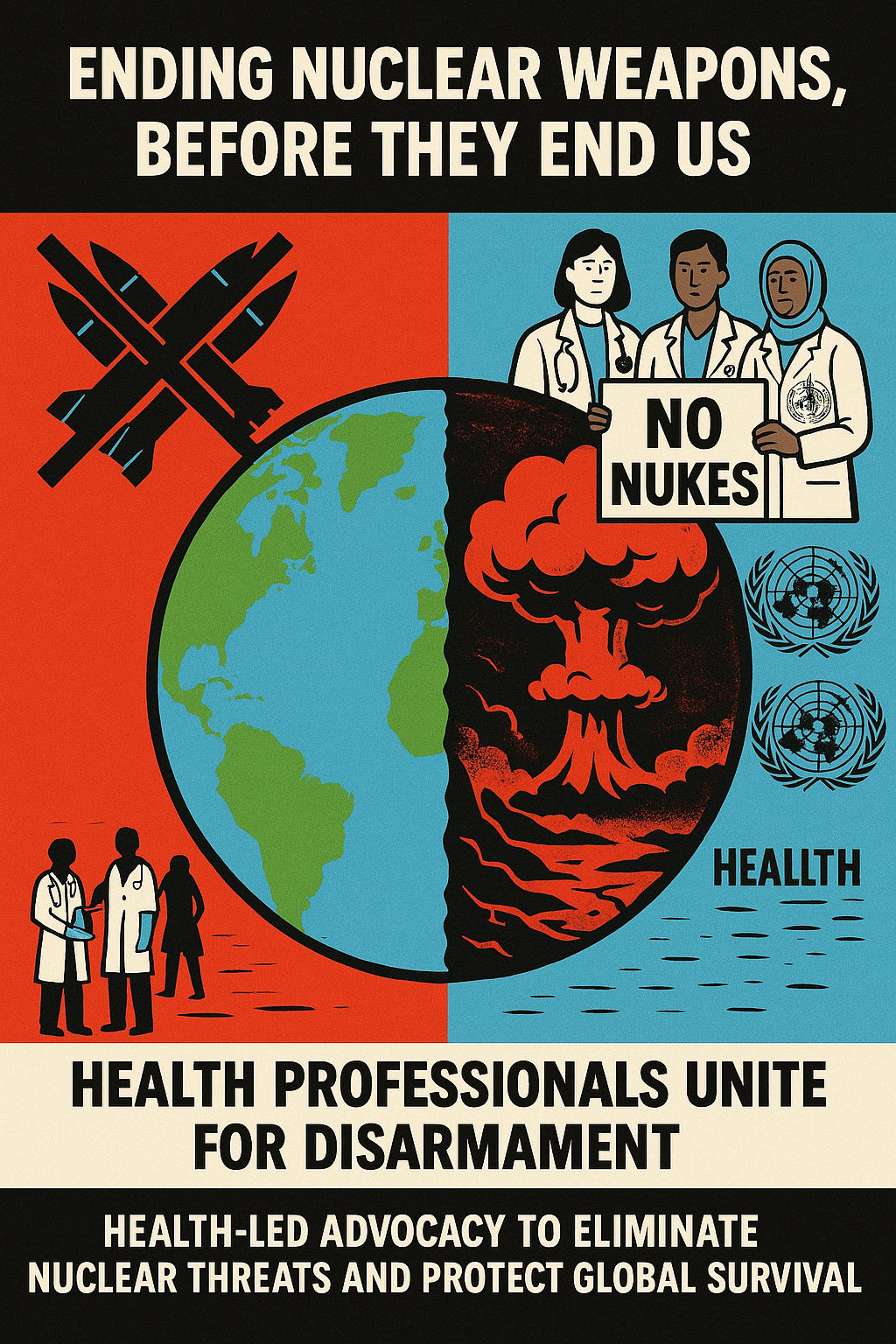Ending nuclear weapons, before they end us
DOI:
https://doi.org/10.63950/gshh.2025.1.1.7Keywords:
Global Health, Disarmament, Nuclear Weapons, Public Health, Radiation InjuriesAbstract
Introduction: This editorial emphasises the urgent need to confront the serious threat posed by nuclear weapons, focusing on their devastating effects on health, the environment, and human well-being. It discusses the upcoming vote at the World Health Assembly (WHA) to renew the World Health Organisation's (WHO) mandate to study these impacts, along with a new United Nations (UN) scientific panel that will analyse the risks associated with nuclear war.
Main Text: Although the number of nuclear weapons has decreased since the Cold War, today’s global stockpile is still dangerously large. Modernisation efforts and ongoing geopolitical tensions increase the chances they might be used. The editorial points out that nuclear conflict could lead to mass extinction, severe climate change, and widespread famine. It criticises the lack of progress in disarmament and calls for immediate steps, such as adopting "no first use" policies and joining the Treaty on the Prohibition of Nuclear Weapons. The authors encourage health professionals to support the renewed WHO mandate and back the UN panel’s work in gathering current evidence to guide policies and inform the public.
Conclusion: The piece frames nuclear disarmament as a critical health issue, emphasising the need for strong political leadership to eliminate these weapons. It appeals to health professionals to rally behind evidence-based policies and the upcoming WHA resolution, pointing out that solid research and public advocacy are essential to prevent disaster.
Downloads
References
1. World Health Organization. Effects of nuclear weapons and war on health and health services. EB156/CONF./10, Executive Board, 5 Feb 2025. https://apps.who.int/gb/ebwha/pdf_files/EB156/B156_CONF10-en.pdf (accessed 4/3/2025).
2. Tomonaga M. The atomic bombings of Hiroshima and Nagasaki: a summary of the human consequences, 1945-2018, and lessons for Homo sapiens to end the nuclear weapon age. Journal for Peace and Nuclear Disarmament 2019;2(2):491-517. https://doi.org/10.1080/25751654.2019.1681226
3. NobelPrize.org, 2024. The Nobel Peace Prize 2024. https://www.nobelprize.org/prizes/peace/2024/summary/ (accessed 25/2/2025).
4. Award ceremony speech. NobelPrize.org. Nobel Prize Outreach 2025. Tue. 25 Feb 2025. https://www.nobelprize.org/prizes/peace/2024/ceremony-speech/ (accessed 25/2/2025).
5. Tannenwald, Nina. The Nuclear Taboo: The United States and the Normative Basis of Nuclear Non-Use. International Organization 1999;53(3):433-468. https://doi.org/10.1162/002081899550959
6. Robock A, Xia L, Harrison CS, Coupe J, Toon OB, Bardeen C. Opinion: How fear of nuclear winter has helped save the world, so far. Atmospheric Chemistry and Physics 2023;23(12):6691-6701. https://doi.org/10.5194/acp-23-6691-2023
7. Helfand I, Haines A, Ruff T, Kristensen H, Lewis P, Mian Z. The growing threat of nuclear war and the role of the health community. World Medical Journal 2016;62(3):86-94.
8. Kristensen H, Korda M, Johns E, Knight M, Kohn K. Status of world nuclear forces. Federation of American Scientists. https://fas.org/initiative/status-world-nuclear-forces/ (accessed 18/3/2025).
9. Norwegian People's Aid. Nuclear weapons ban monitor 2024. February 2025. https://banmonitor.org/ (accessed 25/3/2025).
10. Science and Security Board. Closer than ever: It is now 89 seconds to midnight. 2025 Doomsday Clock Statement. Bulletin of the Atomic Scientists. 28 Jan 2025. https://thebulletin.org/doomsday-clock/2025-statement/ (accessed 4/3/2025).
11. Xia L, Robock A, Scherrer K, et al. Global food insecurity and famine from reduced crop, marine fishery and livestock production due to climate disruption from nuclear war soot injection. Nat Food 2022; 3: 586–96. https://doi.org/10.1038/s43016-022-00573-0
12. United Nations General Assembly. Nuclear war and scientific research. A/C.1/79/L.39 15 Oct 2024. https://reachingcriticalwill.org/images/documents/Disarmament-fora/1com/1com24/resolutions/L39-.pdf (accessed 4/3/2025).
13. https://reachingcriticalwill.org/images/documents/Disarmament-fora/1com/1com24/votes-ga/408DRXVII.pdf (accessed 4/3/25).
14. World Health Organization. Effects of nuclear war on health and health services, 2nd ed. Geneva, WHO, 1987. https://iris.who.int/handle/10665/39199 (accessed 4/3/2025).
15. World Health Organization. Health and environmental effects of nuclear weapons. WHA46/30. 26 April 1993. https://iris.who.int/bitstream/handle/10665/175987/WHA46_30_eng.pdf?isAllowed=y&sequence=1 (accessed 4.3.2025).
16. Abbasi K, Ali P, Barbour V, et al. Reducing the risks of nuclear war. BMJ 2023;382: p1682. https://doi.org/10.1136/bmj.p1682
17. United Nations, 2017. Treaty on the Prohibition of Nuclear Weapons. https://www.icanw.org/tpnw_full_text (accessed 9/3/2025).

Downloads
Published
Data Availability Statement
Not applicable
Issue
Section
License
Copyright (c) 2025 Zielinski C, International Physicians for the Prevention of Nuclear War Supporters (Author)

This work is licensed under a Creative Commons Attribution-NonCommercial 4.0 International License.

